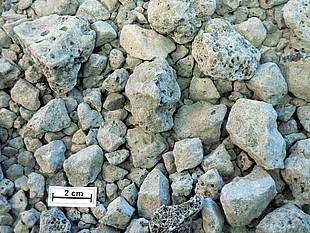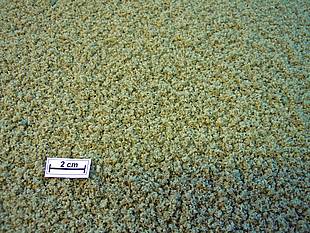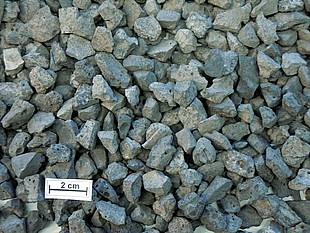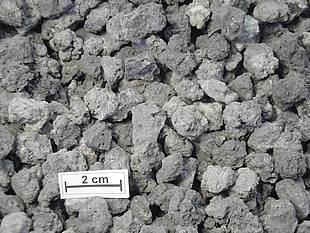Properties
Chemical properties of different types of ferrous slag vary depending on the specific production process. A common characteristic of these slags is that they result from lime and silica based melts, therefore calcium oxide (CaO) and silica (SiO2) are their primary components. Other components include alumina (Al2O3) and magnesium oxide (MgO). The content of iron (Fe) in blast furnace slag (ABS/GBS) is usually lower than 0.5 wt. % since it results from a reduction process. In contrast to blast furnace slag, basic oxygen furnace slag (BOS) and electric arc furnace (EAF) slag (steel slags) are generated in an oxidizing process and therefore have iron contents that are significantly higher.
Typical compositional ranges of iron and steel slags:
| Constituent | Blast furnace slag | Steel Slag |
|---|---|---|
| wt. % | wt. % | |
| CaO | 35 - 42 | 35 - 45 |
| SiO2 | 33 - 38 | 11 - 17 |
| Al2O3 | 10 - 15 | 1 - 6 |
| MgO | 7 - 12 | 2 - 9 |
| FeO | ≤ 1,0 | 16 - 26 |
| MnO | ≤ 1,0 | 2 - 6 |
| P2O5 | - | 1 - 2 |
| Stotal | 1 - 1,5 | ≤ 0,2 |
| Cr2O3 | ≤ 0,1 | 0,5 - 2 |
The mineral composition of blast furnace slag generally consists of melilite (Ca2MgSi2O7 - Ca2Al2SiO7) and merwinite (Ca3MgSi2O8). Steelmaking slag (BOS or EAF) mainly consist of dicalciumsilicate (Ca2SiO4), dicalciumferrite (Ca2Fe2O5) and wuestite (Fe1 -x- y,Mgx,Mny)Oz.
The physical properties of iron and steel slags depend on the chemistry as well as the cooling condition and can be influenced by processing once the slag is removed from the furnace. Slow cooling, for example, generates crystalline blast furnace and steel slag. Quenching the liquid slag (e.g., granulation) on the other hand will generate a vitreous slag with latent hydraulic properties.
All measures including processing of the solid and crystalline slag (e.g., crushing and screening) is done to ensure that the produced aggregates and mixtures conform to requirements given in relevant European standards and regulations. In the end, the chemical, mineralogical and physical properties of iron and steel slags are similar to those of natural rocks. Thus, most fields of application are identical to those of natural rocks (see Applications). The high density, the low impact value, the high compressive strength as well as the good polishing and freeze/thaw resistance – all these unique properties make iron and steel slag ideally suitable for use in road constructions. Further, the cubical shape and the rough surface texture of slag provide excellent resistance to the formation of ruts in surface course asphalt.
Some properties of iron and steel slag aggregates compared to natural rocks:
| Property | Blast furnace slag | Steel slag | Basalt | Greywacke |
|---|---|---|---|---|
| particle density (g/cm3) | 2,4 | 3,6 | 3,0 | 2,7 |
| compressive strength (N/mm2) | 100 | 200 | 300 | 200 |
| impact value (%) | 27 | 17 | 17 | 20 |
| resistance to polishing (PSV) | 50 | 57 | 50 | 56 |
| water absorption (%) | 2 | 1 | <0.5 | <0.5 |
| resistance to freeze/thaw (%) | <0.5 | <0.5 | <0.5 | <0.5 |




